产销首破3000万辆
中国汽车业跨上新台阶
2023年对于中国汽车产业来说是创造历史的一年,同样也是值得铭记的一年。这一年,中国汽车工业迎来70周年,汽车产销量首次突破3000万辆,连续15年位居全球第一。
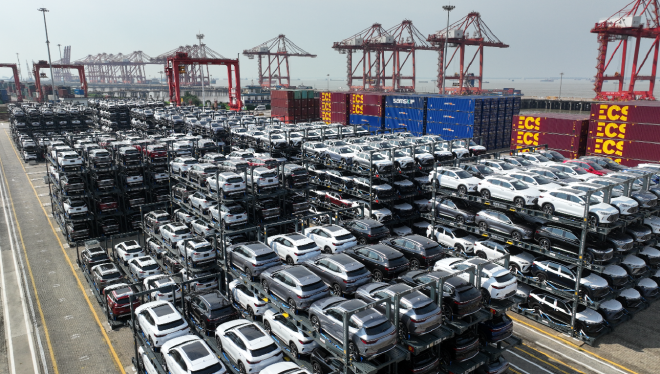
这一年,中国新能源汽车产销也超过了900万辆,新能源汽车渗透率达到30%以上,继续领跑全球,而491万辆的出口销量也让中国成为全球第一汽车出口大国。
可以说,从蹒跚起步到产销首超3000万辆,从依赖进口到海外市场不断壮大,从以市场换技术到如今的技术反向输出……经历了70余年的发展,中国汽车产业逐步壮大,成为工业经济增长的重要组成部分。
因此,站在产销3000万辆发展新阶段节点,我国汽车行业该如何继续高质量发展下去仍然值得探讨。
3000万辆,迈向汽车强国新起点
根据中国汽车工业协会数据统计,2023年全年中国汽车产量为3016.1万辆,同比增长11.6%;全年销量3009.4万辆,同比增长12%,产销首次突破3000万大关,连续15年位居全球第一。
另外,中国新能源汽车持续领跑全球,2023年新能源车产销分别为958.7万辆和949.5万辆,同比分别增长35.8%和37.9%,新能源车渗透率达到31.6%,比2022年提高5.9个百分点。
值得一提的是,2023年中国汽车产业出口也是一大亮点。去年全年汽车整车出口491万辆,同比增长57.9%,首次跃居全球第一。其中,新能源汽车出口120.3万辆,同比增长77.6%,为全球消费者提供了多样化的消费选择。
展望2024年,中国汽车工业协会给出的预测是中国汽车总销量将超过3100万辆,同比增长3%或以上。其中,乘用车销量2680万辆,同比增长3%;新能源汽车销量1150万辆,出口为550万辆。
可以看出,尽管2023年汽车行业经历了艰难时刻,但一连串喜人的数字代表了中国汽车产业的成就,在中国汽车产业发展史上具有新的里程碑意义。
对此行业人士表示,3000万辆,是一个庞大的汽车体量,基本相当于美国、日本、韩国、德国一年的销售总量;3000万辆,意味着中国汽车销量将超过2017年2888万辆的历史最高点,迈上新台阶。
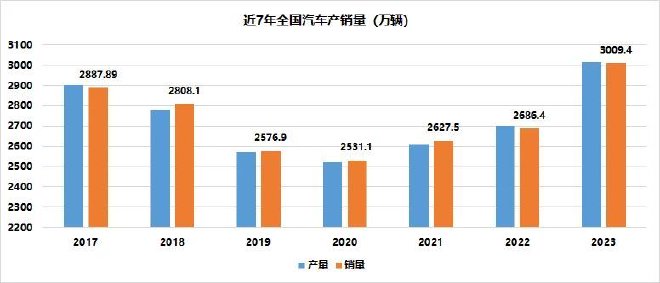
自从2009年中国汽车产销量超越美国成为全球第一,这一纪录已经连续保持了15年。值得一提的是,2017年,我国汽车产销分别达到了2901.5万辆和2887.9万辆,第一次达到峰值,尽管之后有所回落,但始终保持在2500万辆以上。
2023年对于全球汽车产业充满了挑战,不过我国汽车产业展现出强大的韧性、潜力和活力,这也从侧面体现出中国市场的规模优势。
与此同时,在产销量突破的同时,我国汽车产业结构也在加快调整步伐,推动质的有效提升。当然,产销实现3000万辆对于中国汽车工业意义重大。
首先,这意味着国内汽车市场发展到更新、更高的阶段,这一点可以参考产销和出口数据,这都是最好的证明。
其次,从国内市场销量结构来看,中国品牌车型市占率和销量都在不断提升,尤其是新能源汽车,在国内市场的渗透率已经超过了40%,并且在智能化、配置、设计等方面在同级市场中有着很强的竞争力,成为消费者购车首选。
根据乘联会发布的数据显示,2023年自主品牌累计份额52%,相对于2022年同期增加4.6个百分点,自主品牌已经成为汽车市场的重要参与者。
与中国品牌销量节节攀升不同的是,主流合资品牌在国内的市场份额正在缩小,大部分合资车企销量处于下滑态势。
此外还有一点不能忽视,当前,汽车产业已成为工业经济增长的主要拉动力和高质量发展的重要载体。而大众牵手小鹏,斯泰兰蒂斯入股零跑,中国企业开始向外资企业输出技术和品牌等,让曾经的“市场换技术”成为过去时。
不过话又说回来,跨上3000万量级新台阶离不开国家政策的有效推动。2023年6月,财政部、工业和信息化部等发布《关于延续和优化新能源汽车车辆购置税减免政策的公告》,明确将新能源汽车购置税减免政策再延长四年,至2027年底。
同年7月21日,国家发展改革委等部门联合印发《关于促进汽车消费的若干措施》,提出优化汽车限购管理政策、支持老旧汽车更新消费等十项措施。
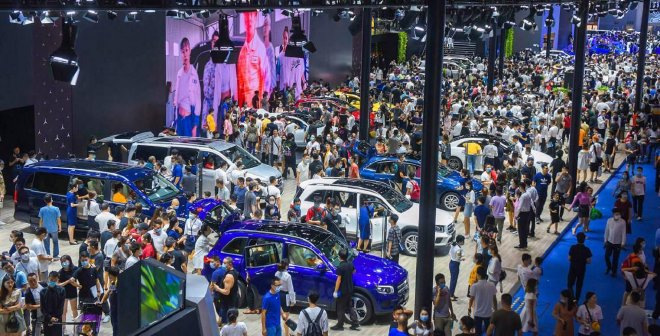
随后12月11日,工业和信息化部、财政部等发布《关于调整减免车辆购置税新能源汽车产品技术要求的公告》,调整减免车辆购置税新能源汽车产品技术要求,引导企业继续提升产品质量和性能,促进产业高质量发展。
在多项政策促销汽车消费之际,各地方也给出了助力,推出购车大礼包,通过发放汽车消费券、放宽限牌、电网改造等扶持政策,切实促进汽车消费。
在各项促销政策的加速实施落地下,汽车市场持续走强,消费潜力得到进一步释放,刺激行业全年实现稳增长目标,有助于全年汽车产销冲击新高点。
渗透率提升,新能源技术不断突破
近年来,中国坚定不移发展新能源汽车,核心技术上也不断取得突破,市场规模和渗透率也在持续攀升。
数据显示,2023年我国新能源汽车产销量分别达到958.7万辆和949.5万辆,同比分别增长35.8%和37.9%,占全球新能源汽车销量六成以上。根据公安部最新数据,截至2023年底,中国新能源汽车保有量已达2041万辆。
回顾历史,我国从生产第一辆新能源汽车到第1000万辆,用了27年;从第1000万辆到突破2000万辆,仅用了17个月,充分展现了“中国速度”。
近年来,在政策和市场的双轮驱动下,我国新能源汽车产销已连续8年位居全球首位,成为整个汽车行业的一抹亮色。值得一提的是,2023年新能源汽车连续8个月市占率超过30%,这说明市场在稳步增长。
值得一提的是,在智能新能源汽车加快发展的同时,中国汽车产业也在积极转型,不少传统燃油车凭借混合动力形式实现了节能减排,相关的核心零部件技术水平也有显著提升。
中国车企在新能源赛道加速奔跑,吸引了众多跨国公司点赞,大众汽车集团管理层表示,中国正在释放巨大的创新潜力,大众在这里看到了积极而又激烈的竞争。另外,在2023慕尼黑车展上,中国成为除东道主德国之外参展商数量最多的国家。
当然,中国新能源汽车之所以快速发展得益于关键技术的不断突破,技术革新是我国新能源汽车产业得以持续发展的重要驱动力。
从智能网联来看,随着智能网联汽车技术水平的不断提升和相关产业的全面融合,智能网联汽车产业正在进入新的发展阶段。
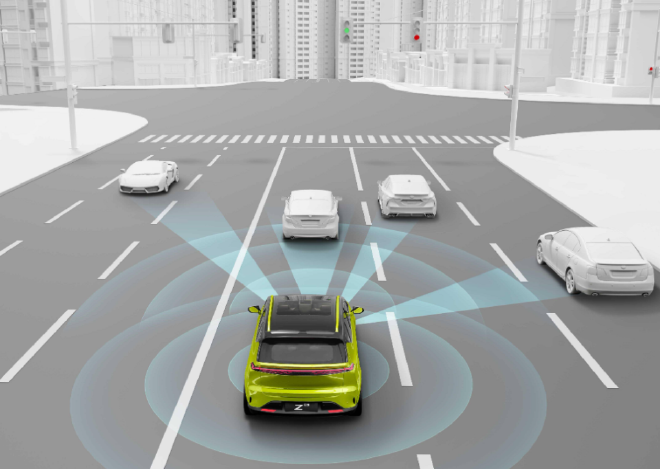
在产业规模上,2022年我国搭载辅助驾驶系统智能网联乘用车销量约为700万辆,市场渗透率达到34.9%,到了2023年上半年,这一数据持续提升,达到了42.4%,年底还在继续攀升。
如果从关键技术上来看,如今新一代电子电气架构、车用操作系统、大算力计算芯片等实现了装车应用,跨域融合与控制器技术实现突破,高性能激光雷达感知范围达到了250米。此外,L2级自动驾驶车型广泛应用,多家车企已经做好了量产L3级车辆的准备。
数据显示,截至目前我国已累计开放测试道路超2.2万公里,累计测试里程超7000万公里,为智能网联技术创新提供了良好的试验测试环境。
同时,随着L3及以上等级自动驾驶车辆上路测试的放开,自动驾驶技术发展和应用将进一步提速,同时也将驱动激光雷达、新一代电子电气架构、大算力计算芯片等先进技术加速迭代升级。
从电池技术来看,中国动力电池的成本也在大幅下降,并且在结构创新方面有了新的突破。2023年,包括宁德时代、中比能源、亿纬锂能、国轩高科、广汽埃安、蜂巢能源、欣旺达、中科院、中科大等电池企业和科研院校,都发布了动力电池创新解决方案。
另外,在驱动电机方面,新能源汽车电机的转速、功率密度不断提高,具备扁线、油冷、高压等特征的新一代产品不断面市,并逐步实现量产装车。
除此之外,在电机控制方面,我国电控产品精度、动态响应速率、开关损耗等方面已达国际先进水平,技术不断成熟,产业链持续完善。
不仅如此,我国充换电基础设施也在不断完善。根据中国充换电联盟发布的《2023年全国电动汽车充换电基础设施运行情况》报告数据显示,2023年充电基础设施增量为338.6万台,桩车增量比为1:2.8。
换电站方面,截止2023年12月我国换电站总数共3567座,排在前五的省市为浙江、广东、江苏、北京、上海。对此中国充电联盟表示,充电基础设施建设基本满足新能源汽车产业快速发展的需求。
为了给消费者提供更便捷的充换电服务,国内新能源汽车补能赛道也在迅猛发展,目前换电和超充是热门选项。
在蔚来牵手长安、吉利、江汽集团、奇瑞组建换电联盟后,近日全国工业和信息化工作会议上也提出针对新能源汽车领域,2024年要支持新能源汽车换电模式发展。
当下,换电模式还在不断内卷,目前的效率已经可以用秒来衡量,有企业宣称可以做到“最快不到1分钟”就能完成换电,换电速度越来越快,比加油还方便。
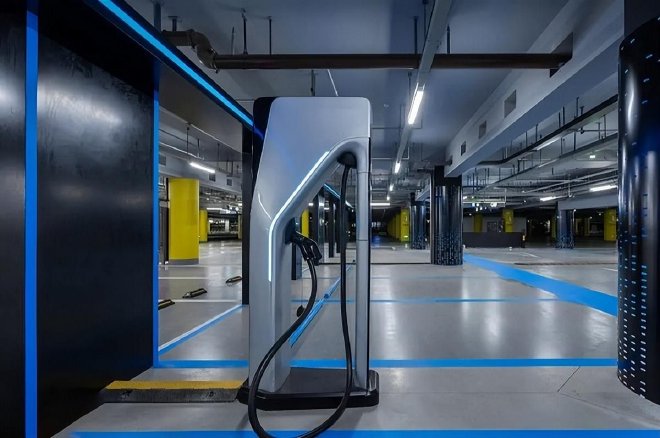
另外,超充在补能新时代也炙手可热,不少车企自建800V超快充桩,比如小鹏、极氪(配置|询价)、理想、蔚来等等。此前广汽埃安发布了超充桩,据悉超充站匹配的是1000V超充系统,35分钟就能使一辆电动汽车的电量从12%充到96%。
此外,华为也推出了全液冷超充桩,可实现设备的高效散热和温度控制,最大输出功率600kW,最大电流600A,是目前投入应用功率最高的充电桩,可实现“充1秒跑1公里”,1辆普通的电动汽车不到10分钟就可以充满电。
可以看到,面对竞争激烈的汽车市场,中国车企在积极投入研发,加强技术创新和产品迭代,不断提高新能源汽车的性能和质量,进一步推动了新能源汽车市场的普及和壮大。
有业内人士表示,新能源汽车已不仅是中国汽车市场增长的主要动力,更是国产汽车品牌实现弯道超车,打造核心竞争力的主要抓手。
出口强势拉动,中国汽车卷向海外
早在上世纪50年代,中国汽车就开始了扬帆出海的历程,不过当时由于产品和技术没有明显竞争优势,所以市场销量表现平平。
时间来到2021年,中国汽车出口首次突破200万辆门槛,达到了201.5万辆,尤其是新能源汽车出口同比猛增304.6%,达到31万辆,因此这一年被看作中国汽车出海元年。
2022年,中国汽车出口竞争力持续增强,全年累计出口超300万辆,达到311.1万辆,同比增长54.4%;新能源出口67.9万辆,同比增长了120%。
2023年,中国汽车出海事业迎来了新突破。中汽协数据显示,我国全年汽车出口量491万辆,同比增长57.9%,汽车出口数量已经超越日本,拿下了全球第一名的好成绩。
当然,中国汽车出海能取得如此不错的成绩,离不开几家企业的突出贡献,其中就包括上汽和奇瑞,两家车企出口量占了总出口的近50%。
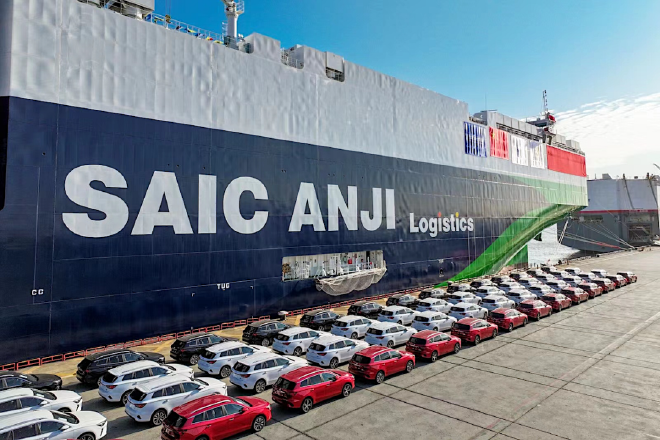
根据上汽集团发布的数据显示, 2023年海外销量达120.8万辆,同比增长18.8%,其中自主品牌销量占比近92%,新能源车销量占比近24%,这也帮助上汽集团连续8年成为中国汽车制造行业中,新车出口量最大的企业。
另外,上汽集团也透露,2024年计划将新车出口规模提升至135万辆,2025年则将向150万辆的目标发起冲击。
奇瑞汽车在出口业务上表现同样出色,2023年全年汽车出口为937148辆,同比增长101.1%,并连续21年位居中国品牌乘用车出口第一。截至目前,奇瑞集团全球汽车用户累计超过1300万,其中海外用户335万。
此外,根据乘联会数据显示,吉利、长城、比亚迪全年出口量也分别超过27万辆、26万辆和24万辆,成功跻身出口量排行榜前十。
中国汽车品牌也海外市场除了销量增长外,中国车企出海的深度也在持续扩大,越来越多的企业热衷拓展海外市场,首当其冲是欧洲市场。
近日,比亚迪宣布将在匈牙利赛格德市建设一个新能源汽车整车生产基地,该基地将分阶段建设,预计为当地创造数千个就业岗位。据悉,这将是中国车企在欧洲建设的首个乘用车生产基地。
除了比亚迪,包括上汽名爵、长安汽车、长城汽车等自主品牌都在筹划在欧洲建厂,一些品牌已经启动选址工作。此前,长安汽车在2023年上海车展上发布了海外战略“海纳百川计划”,其中就提到了要加快布局欧洲。
值得一提的是,长城汽车也在加速海外布局,并计划全面进入欧洲市场,继德国和英国市场之后,长城汽车计划进一步扩展至8个欧洲国家新市场。
当然造车新势力也没有落后,位于匈牙利佩斯州的蔚来欧洲能源工厂已于2023年9月投入运营,哪吒汽车也在考虑建设欧洲工厂,哪吒GT(配置|询价)也即将开启海外销售征程。
哪吒创始人兼首席执行官张勇此前曾表示,先期会以贸易的形式进入欧洲市场,未来会考虑建厂,但大概率会以合作的方式落地,利用当地的现有产能。
除了欧洲,中国车企也热衷在泰国、巴西建厂,其中广汽埃安投资约13亿人民币在泰国建设电动汽车工厂;比亚迪于在巴西设立由三座工厂组成的大型生产基地综合体,比亚迪的泰国工厂也已经动工建设,计划2024年投产。
此外,2023年5月,长城汽车对外表示,巴西工厂将成为巴西首个专门生产混合动力汽车和电动汽车的新能源汽车工厂,估计明年上半年就能启动运营……
尽管欧盟委员会2023年发布公告称,对进口自中国的纯电动载人汽车发起反补贴调查,但这并未能阻挡中国车企选择在欧洲建厂的步伐,毕竟随着出口规模不断增大,在海外建厂、提升本土化程度是必然趋势。
小结:站在3000万量级新台阶,2024年的汽车市场仍然充满挑战,行业也会加速洗牌,在这一轮淘汰赛中部分车企会快速成长,也有一些日子会更难过,这也是行业向前必然经历的过程。对于中国汽车企业来说,创新技术和降本增效成为竞争力核心,也是中国汽车产业领跑全球的有利筹码。
China's automotive industry has reached a new level
2023 is a year of creating history for the Chinese automotive industry, and it is also a year worth remembering. This year, China's automotive industry celebrated its 70th anniversary, with the production and sales of automobiles exceeding 30 million units for the first time, ranking first in the world for 15 consecutive years.
Production and sales exceeded 30 million vehicles for the first time, and China's automotive industry has reached a new level
This year, China's production and sales of new energy vehicles also exceeded 9 million, with a penetration rate of over 30%, continuing to lead the world. The export sales of 4.91 million vehicles also made China the world's largest exporter of automobiles.
It can be said that after more than 70 years of development, China's automobile industry has gradually grown and become an important component of industrial economic growth, from a stumbling start to production and sales exceeding 30 million vehicles, from dependence on imports to continuous growth in overseas markets, from exchanging technology for market to the current reverse export of technology.
Therefore, standing at a new stage of development with a production and sales volume of 30 million vehicles, it is still worth exploring how China's automotive industry can continue to develop with high quality.
30 million vehicles, moving towards a new starting point of becoming an automotive powerhouse
According to data from the China Association of Automobile Manufacturers, China's total automobile production in 2023 was 30.161 million units, a year-on-year increase of 11.6%; The annual sales volume was 30.094 million vehicles, a year-on-year increase of 12%, and the production and sales exceeded the 30 million mark for the first time, ranking first in the world for 15 consecutive years.
In addition, China's new energy vehicles continue to lead the world, with production and sales of 9.587 million and 9.495 million new energy vehicles in 2023, an increase of 35.8% and 37.9% year-on-year, respectively. The penetration rate of new energy vehicles reached 31.6%, an increase of 5.9 percentage points from 2022.
It is worth mentioning that the export of China's automotive industry in 2023 is also a major highlight. Last year, the total export of automobiles reached 4.91 million units, a year-on-year increase of 57.9%, ranking first in the world for the first time. Among them, the export of new energy vehicles was 1.203 million, a year-on-year increase of 77.6%, providing diversified consumption choices for global consumers.
Looking ahead to 2024, the China Association of Automobile Manufacturers predicts that the total sales of automobiles in China will exceed 31 million units, a year-on-year increase of 3% or more. Among them, passenger car sales reached 26.8 million units, a year-on-year increase of 3%; The sales volume of new energy vehicles is 11.5 million, with exports of 5.5 million.
It can be seen that although the automotive industry has experienced difficult times in 2023, a series of impressive numbers represent the achievements of China's automotive industry and have new milestone significance in the development history of China's automotive industry.
Industry insiders say that 30 million vehicles are a huge volume of cars, basically equivalent to the annual sales volume of the United States, Japan, South Korea, and Germany; 30 million vehicles means that China's automobile sales will exceed the historical high of 28.88 million vehicles in 2017, reaching a new level.
Production and sales exceeded 30 million vehicles for the first time, and China's automotive industry has reached a new level
Since 2009, China's automobile production and sales surpassed the United States to become the world's number one, this record has been maintained for 15 consecutive years. It is worth mentioning that in 2017, China's automobile production and sales reached 29.015 million and 28.879 million respectively, reaching their peak for the first time. Although there has been a slight decline since then, they have remained above 25 million vehicles.
2023 is full of challenges for the global automotive industry, but China's automotive industry has shown strong resilience, potential, and vitality, which also indirectly reflects the scale advantage of the Chinese market.
At the same time, while production and sales have broken through, China's automotive industry structure is also accelerating its adjustment pace, promoting effective improvement in quality. Of course, achieving production and sales of 30 million vehicles is of great significance to China's automotive industry.
Firstly, this means that the domestic automotive market has reached a new and higher stage of development, which can be evidenced by production, sales, and export data.
Secondly, from the perspective of sales structure in the domestic market, the market share and sales volume of Chinese brand car models are constantly increasing, especially new energy vehicles, which have a penetration rate of over 40% in the domestic market and have strong competitiveness in intelligence, configuration, design, and other aspects in the same level of market, becoming the first choice for consumers to purchase cars.
According to data released by the China Association of Automobile Manufacturers, the cumulative share of domestic brands in 2023 was 52%, an increase of 4.6 percentage points compared to the same period in 2022. Domestic brands have become an important participant in the automotive market.
Unlike the continuous increase in sales of Chinese brands, the market share of mainstream joint venture brands in China is shrinking, and most joint venture car companies are experiencing a decline in sales.
In addition, there is one thing that cannot be ignored. Currently, the automotive industry has become the main driving force for industrial economic growth and an important carrier for high-quality development. And with Volkswagen holding hands with Xiaopeng and Stellantis investing in Zero Run, Chinese companies have begun to export technology and brands to foreign companies, making the past of "market for technology" a thing of the past.
However, on the other hand, reaching a new level of 30 million yuan cannot be achieved without the effective promotion of national policies. In June 2023, the Ministry of Finance, the Ministry of Industry and Information Technology, and others issued a notice on the continuation and optimization of the new energy vehicle purchase tax reduction policy, which clearly extended the new energy vehicle purchase tax reduction policy for another four years until the end of 2027.
On July 21 of the same year, the National Development and Reform Commission and other departments jointly issued the "Several Measures to Promote Automobile Consumption", proposing ten measures to optimize automobile purchase restriction management policies and support the renewal and consumption of old cars.
Production and sales exceeded 30 million vehicles for the first time, and China's automotive industry has reached a new level
On December 11th, the Ministry of Industry and Information Technology, the Ministry of Finance, and others issued a notice on adjusting the technical requirements for new energy vehicle products with reduced or exempted vehicle purchase tax, guiding enterprises to continue improving product quality and performance, and promoting high-quality development of the industry.
While promoting car consumption through multiple policies, various regions have also provided assistance by launching car purchase gift packages, and effectively promoting car consumption through policies such as distributing car consumption vouchers, relaxing license plate restrictions, and upgrading the power grid.
With the accelerated implementation of various promotional policies, the automotive market continues to strengthen, further unleashing consumer potential, stimulating the industry to achieve stable growth targets throughout the year, and helping to hit new highs in automotive production and sales throughout the year.
Increased penetration rate and continuous breakthroughs in new energy technologies
In recent years, China has been steadfastly developing new energy vehicles, continuously making breakthroughs in core technologies, and continuously increasing market size and penetration rate.
Data shows that in 2023, the production and sales of new energy vehicles in China reached 9.587 million and 9.495 million, respectively, with year-on-year growth of 35.8% and 37.9%, accounting for more than 60% of global new energy vehicle sales. According to the latest data from the Ministry of Public Security, as of the end of 2023, the number of new energy vehicles in China has reached 20.41 million.
Looking back at history, it took 27 years for China to produce its first new energy vehicle and reach its 10th million vehicles; It only took 17 months from the 10th to the breakthrough of 20 million vehicles, fully demonstrating the speed of China.
In recent years, driven by both policies and the market, China's production and sales of new energy vehicles have ranked first in the world for 8 consecutive years, becoming a bright spot in the entire automotive industry. It is worth mentioning that in 2023, the market share of new energy vehicles exceeded 30% for 8 consecutive months, indicating that the market is steadily growing.
It is worth mentioning that while the development of intelligent new energy vehicles is accelerating, the Chinese automotive industry is also actively transforming. Many traditional fuel vehicles have achieved energy conservation and emission reduction through hybrid forms, and the technical level of related core components has also significantly improved.
Chinese car companies are accelerating on the new energy track, attracting praise from many multinational companies. The management of Volkswagen Group stated that China is unleashing huge innovation potential, and Volkswagen is witnessing positive and fierce competition here. In addition, at the 2023 Munich Auto Show, China became the country with the highest number of exhibitors after the host country Germany.
Of course, the rapid development of new energy vehicles in China is due to the continuous breakthroughs in key technologies, and technological innovation is an important driving force for the sustainable development of China's new energy vehicle industry.
From the perspective of intelligent connected vehicles, with the continuous improvement of intelligent connected vehicle technology and the comprehensive integration of related industries, the intelligent connected vehicle industry is entering a new stage of development.
Production and sales exceeded 30 million vehicles for the first time, and China's automotive industry has reached a new level
In terms of industrial scale, the sales of intelligent connected passenger vehicles equipped with assisted driving systems in China reached approximately 7 million units in 2022, with a market penetration rate of 34.9%. By the first half of 2023, this figure continued to increase, reaching 42.4%, and continued to rise by the end of the year.
If we look at the key technologies, the new generation of electronic and electrical architecture, automotive operating systems, and high computing power computing chips have been implemented for vehicle applications. Cross domain fusion and controller technology have achieved breakthroughs, and the high-performance LiDAR sensing range has reached 250 meters. In addition, L2 level autonomous driving models are widely used, and many car companies are ready to mass produce L3 level vehicles.
Data shows that as of now, China has opened over 22000 kilometers of testing roads and over 70 million kilometers of testing mileage, providing a good testing environment for the innovation of intelligent networking technology.
At the same time, with the release of road testing for L3 and above level autonomous vehicles, the development and application of autonomous driving technology will further accelerate, and it will also drive advanced technologies such as LiDAR, new generation electronic and electrical architecture, and high computing power computing chips to accelerate iteration and upgrading.
From the perspective of battery technology, the cost of power batteries in China is also significantly decreasing, and there have been new breakthroughs in structural innovation. In 2023, battery companies and research institutions including CATL, Zhongbi Energy, Yiwei Lithium Energy, Guoxuan High tech, GAC Aian, Honeycomb Energy, Xinwangda, Chinese Academy of Sciences, and University of Science and Technology of China have all released innovative solutions for power batteries.
In addition, in terms of driving motors, the speed and power density of new energy vehicle motors continue to increase. The new generation of products with characteristics such as flat wire, oil cooling, and high pressure are not available on the market, and are gradually being mass-produced and installed on vehicles.
In addition, in terms of motor control, China's electronic control products have reached international advanced levels in terms of accuracy, dynamic response rate, switch losses, and other aspects. The technology is constantly maturing, and the industrial chain is continuously improving.
Not only that, China's charging and swapping infrastructure is also constantly improving. According to the report "Operation of National Electric Vehicle Charging and Swapping Infrastructure in 2023" released by the China Charging and Swapping Alliance, the increment of charging infrastructure in 2023 was 3.386 million units, with a pile to vehicle increment ratio of 1:2.8.
In terms of power exchange stations, as of December 2023, China has a total of 3567 power exchange stations, with Zhejiang, Guangdong, Jiangsu, Beijing, and Shanghai ranking among the top five provinces and cities. The China Charging Alliance stated that the construction of charging infrastructure basically meets the needs of the rapid development of the new energy vehicle industry.
In order to provide consumers with more convenient charging and swapping services, the domestic new energy vehicle energy replenishment track is also rapidly developing, and currently battery swapping and overcharging are popular options.
After joining hands with Changan, Geely, Jiangqi Group, and Chery to form a battery swapping alliance, NIO recently proposed at the National Industrial and Information Technology Work Conference to support the development of new energy vehicle battery swapping models in the field of new energy vehicles in 2024.
At present, the battery swapping mode is still constantly evolving, and its efficiency can be measured in seconds. Some companies claim to be able to complete battery swapping in less than 1 minute at the fastest, and the speed of battery swapping is getting faster and more convenient than refueling.
Production and sales exceeded 30 million vehicles for the first time, and China's automotive industry has reached a new level
In addition, overcharging is also very popular in the new era of energy replenishment. Many car companies have built their own 800V ultra fast charging piles, such as Xiaopeng, Jike (configuration | inquiry), Ideal, NIO, and so on. Previously, GAC Aion released an overcharging station, which is reportedly matched with a 1000V overcharging system. It can charge an electric vehicle from 12% to 96% in 35 minutes.
In addition, Huawei has also launched fully liquid cooled supercharging piles, which can achieve efficient heat dissipation and temperature control of the equipment. The maximum output power is 600kW and the maximum current is 600A, making it the highest power charging pile currently put into use. It can achieve "charging for 1 second and running for 1 kilometer", and a regular electric vehicle can be fully charged in less than 10 minutes.
It can be seen that in the fiercely competitive automotive market, Chinese car companies are actively investing in research and development, strengthening technological innovation and product iteration, continuously improving the performance and quality of new energy vehicles, and further promoting the popularization and growth of the new energy vehicle market.
Industry insiders have stated that new energy vehicles are not only the main driving force for the growth of the Chinese automotive market, but also the main lever for domestic automotive brands to achieve overtaking on curves and build core competitiveness.
Strong export drive, Chinese cars rolling overseas
As early as the 1950s, Chinese cars began their journey of going global. However, at that time, due to the lack of obvious competitive advantages in products and technology, the market sales performance was mediocre.
In 2021, China's automobile exports exceeded the threshold of 2 million vehicles for the first time, reaching 2.015 million vehicles. Especially, the export of new energy vehicles increased by 304.6% year-on-year, reaching 310000 vehicles. Therefore, this year is regarded as the first year for China's automobile exports to the world.
In 2022, China's automobile export competitiveness continued to strengthen, with a cumulative export of over 3 million vehicles throughout the year, reaching 3.111 million vehicles, a year-on-year increase of 54.4%; The export of new energy reached 679000 vehicles, a year-on-year increase of 120%.
In 2023, China's automobile overseas business has achieved new breakthroughs. According to data from the China Association of Automobile Manufacturers, China's annual automobile exports reached 4.91 million units, a year-on-year increase of 57.9%. The number of automobile exports has surpassed Japan, achieving a good result of ranking first in the world.
Of course, the remarkable achievements of Chinese cars going global are inseparable from the outstanding contributions of several companies, including SAIC and Chery, whose exports account for nearly 50% of the total exports.
Production and sales exceeded 30 million vehicles for the first time, and China's automotive industry has reached a new level
According to data released by SAIC Group, overseas sales reached 1.208 million vehicles in 2023, a year-on-year increase of 18.8%, with domestic brand sales accounting for nearly 92% and new energy vehicle sales accounting for nearly 24%. This has also helped SAIC Group become the largest exporter of new vehicles in China's automotive manufacturing industry for 8 consecutive years.
In addition, SAIC Group has also revealed that it plans to increase the scale of new car exports to 1.35 million vehicles in 2024, and will launch an attack on the target of 1.5 million vehicles in 2025.
Chery Automobile has also performed well in its export business, with a total of 937148 vehicles exported in 2023, a year-on-year increase of 101.1%, and has ranked first in the export of Chinese brand passenger cars for 21 consecutive years. As of now, Chery Group has accumulated over 13 million global automotive users, including 3.35 million overseas users.
In addition, according to data from the China Association of Automobile Manufacturers, Geely, Great Wall Motors, and BYD have exported over 270000, 260000, and 240000 vehicles respectively throughout the year, successfully ranking among the top ten in terms of export volume.
In addition to increasing sales, Chinese car brands are also expanding their overseas markets. More and more companies are eager to expand their overseas markets, with the European market being the first to be affected.
Recently, BYD announced that it will build a new energy vehicle production base in Seged, Hungary. The base will be built in stages and is expected to create thousands of job opportunities in the local area. It is reported that this will be the first passenger car production base built by Chinese car companies in Europe.
In addition to BYD, domestic brands such as SAIC MG, Changan Automobile, and Great Wall Motors are all planning to build factories in Europe, and some brands have already started site selection work. Previously, Changan Automobile released its overseas strategy "Embracing All Rivers Plan" at the 2023 Shanghai Auto Show, which mentioned accelerating its layout in Europe.
It is worth mentioning that Great Wall Motors is also accelerating its overseas layout and plans to fully enter the European market. Following the German and British markets, Great Wall Motors plans to further expand to new markets in 8 European countries.
Of course, the new forces in car manufacturing are not lagging behind. The NIO European Energy Factory located in Pest, Hungary has been put into operation in September 2023, and Nezha Motors is also considering building a European factory. Nezha GT (configuration | inquiry) is also about to embark on an overseas sales journey.
Zhang Yong, founder and CEO of Nezha, previously stated that he will enter the European market through trade in the early stage and will consider building factories in the future, but it is highly likely to be implemented through cooperation, utilizing existing local production capacity.
In addition to Europe, Chinese car companies are also enthusiastic about building factories in Thailand and Brazil, with GAC Aion investing approximately 1.3 billion yuan to build electric vehicle factories in Thailand; BYD has established a large-scale production base complex consisting of three factories in Brazil, and its Thai factory has also started construction, with plans to start production in 2024.
In addition, in May 2023, Great Wall Motors announced to the public that its Brazilian factory will become Brazil's first new energy vehicle factory specializing in the production of hybrid and electric vehicles, and is expected to start operation in the first half of next year
Although the European Commission announced in 2023 that it would launch a countervailing investigation into pure electric passenger vehicles imported from China, this has not stopped Chinese car companies from choosing to build factories in Europe. After all, with the increasing export scale, building factories overseas and improving localization are inevitable trends.
Summary: Standing on a new level of 30 million yuan, the automotive market in 2024 is still full of challenges, and the industry will accelerate its reshuffle. In this round of elimination, some car companies will grow rapidly, and some days will be even more difficult. This is also an inevitable process for the industry to move forward. For Chinese automotive companies, innovative technology and cost reduction and efficiency enhancement have become the core competitiveness, and are also advantageous chips for China's automotive industry to lead the world.

